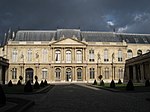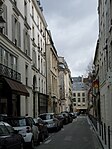The Marais
3rd arrondissement of Paris4th arrondissement of ParisAll pages needing cleanupChinatowns in EuropeDistricts of Paris ... and 8 more
Entertainment districts in FranceGay villages in FranceJewish French historyJewish communitiesLGBT culture in ParisLe MaraisTourist attractions in ParisWikipedia introduction cleanup from April 2019

The Marais (Le Marais French: [lə maʁɛ] (listen); "the marsh") is a historic district in Paris, France. Long the aristocratic district of Paris, it hosts many outstanding buildings of historic and architectural importance. It spreads across parts of the 3rd and 4th arrondissements in Paris (on the Rive Droite, or Right Bank, of the Seine). Once shabby, the district has been rehabilitated and now sports trendy shopping and restaurants in streets such as Rue des Francs-Bourgeois and Rue des Rosiers.
Excerpt from the Wikipedia article The Marais (License: CC BY-SA 3.0, Authors, Images).The Marais
Rue Vieille du Temple, Paris 3rd Arrondissement (Paris)
Geographical coordinates (GPS) Address Nearby Places Show on map
Geographical coordinates (GPS)
| Latitude | Longitude |
|---|---|
| N 48.86 ° | E 2.3608333333333 ° |
Address
Muse
Rue Vieille du Temple
75003 Paris, 3rd Arrondissement (Paris)
Ile-de-France, France
Open on Google Maps










